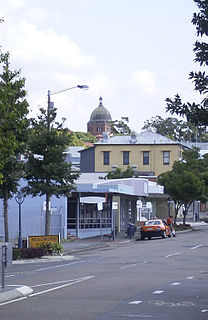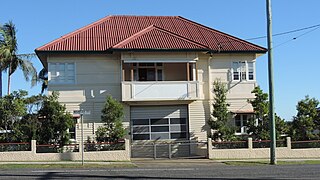
Yeronga Fire Station is a heritage-listed former fire station at 785 Ipswich Road, Yeronga, City of Brisbane, Queensland, Australia. It was designed by architectural firm Atkinson and Conrad, and built in 1934 by contractor William Allen Miller. It is a two-storey timber structure adjacent to Yeronga Park, and originally housed the station facilities on the ground floor and a residence for the superintendent on the first floor, a combination typical for Brisbane fire stations of this era.

Chelmer Police College is a heritage-listed former police barracks at 17 Laurel Avenue, Chelmer, City of Brisbane, Queensland, Australia. It was built from 1900 to 1970. It is also known as 10 WRAAC Barracks, The Lady Wilson Red Cross Convalescent Home, and Waterton. It was added to the Queensland Heritage Register on 1 October 2003.
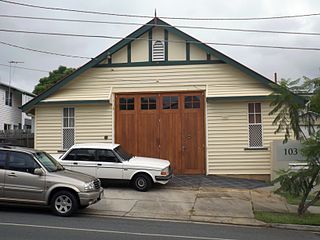
Balmoral Fire Station is a heritage-listed fire station at 105 Pashen Street, Morningside, Queensland, Australia. It was designed by architects Atkinson and Conrad and built from c. 1926 to 1929 by C. King. It was added to the Queensland Heritage Register on 26 November 1999.

Silverwells is a heritage-listed duplex at 261 - 267 Main Street, Kangaroo Point, Queensland, Australia. It was built from 1860s circa to 1860s circa. It is also known as Bishopcroft, Blairgowie, and Morningside. It was added to the Queensland Heritage Register on 21 October 1992.

Woolloongabba Police Station is a heritage-listed former police station at 842–848 Main Street, Woolloongabba, City of Brisbane, Queensland, Australia. It was designed by the Queensland Department of Public Works and built from 1913 to 1936. It is also known as South Coast District Headquarters and Woolloongabba Police Station. It was added to the Queensland Heritage Register on 25 November 1994.

Wynnum Ambulance Station is a heritage-listed museum and former ambulance station at 33 Tingal Road, Wynnum, City of Brisbane, Queensland, Australia. It was built from 1926 to 1927. It is also known as the Queensland Ambulance Museum and the QATB Station. It was added to the Queensland Heritage Register on 26 March 1999. It is open by appointment.
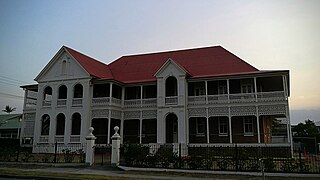
Mount Carmel Convent is a heritage-listed former Roman Catholic convent at 199 Bay Terrace, Wynnum, City of Brisbane, Queensland, Australia. It was designed by Hall & Dods and built in 1915 by William Richard Juster. It was added to the Queensland Heritage Register on 27 August 1999.

The Michael Gannon residence is a heritage-listed holiday home at 150 Kingsley Terrace, Manly, City of Brisbane, Queensland, Australia. It was built c. 1888. It was added to the Queensland Heritage Register on 27 October 2000.

Albion Fire Station is a heritage-listed former fire station at 42 Bridge Street, Wooloowin, City of Brisbane, Queensland, Australia. It was designed by Department of Public Works and built from 1925 to 1927. It was added to the Queensland Heritage Register on 28 February 2003.

Victoria Flats is a heritage-listed apartment block at 369 Gregory Terrace, Spring Hill, City of Brisbane, Queensland, Australia. It was designed by architect Thomas Blair Moncrieff Wightman and built c. 1922 by Cheesman & Bull. It is also known as Kilroe's Flats and Morella, Carinyah, Lumtah and Neerim. It was added to the Queensland Heritage Register on 30 March 2001.

Toronto is a heritage-listed detached house at 30 Quarry Street, Ipswich, City of Ipswich, Queensland, Australia. It was built from 1863 onwards. It is also known as Devonshire Cottage. It was added to the Queensland Heritage Register on 21 October 1992.
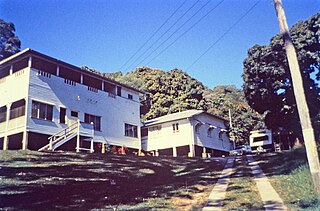
Halse Lodge is a heritage-listed boarding house at 17 Noosa Drive, Noosa Heads, Shire of Noosa, Queensland, Australia. It was built from 1880s to 1920s. It is also known as Bay View and Hillcrest Guest House. It was added to the Queensland Heritage Register on 30 April 1997.

Railway Hotel is a heritage-listed hotel at 1 Station Road, Gympie, Gympie Region, Queensland, Australia. It was designed by Alexander Brown Wilson and built in 1915 by J J Georges. It was added to the Queensland Heritage Register on 12 June 2008.

West End Hotel is a heritage-listed hotel at 89 Ingham Road, West End, City of Townsville, Queensland, Australia. It was built in 1885 by Peter Dean. It was added to the Queensland Heritage Register on 24 June 1999.
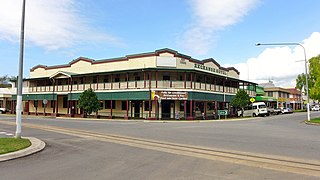
Exchange Hotel is a heritage-listed hotel at 2 Front Street, Mossman, Shire of Douglas, Queensland, Australia. It was designed by Vibert McKirdy Brown and built from 1934 to 1935. It was also known as Daintree Inn. It was added to the Queensland Heritage Register on 9 November 2012.

Dalby Fire Station is a heritage-listed fire station at 21 New Street, Dalby, Western Downs Region, Queensland, Australia. It was designed by Matthew Williamson and built in 1935 by George Ficken. It was added to the Queensland Heritage Register on 8 October 2010.

Cannon Hill State School is a heritage-listed state school at 845 Wynnum Road, Cannon Hill, City of Brisbane, Queensland, Australia. It was added to the Queensland Heritage Register on 12 June 2015.

Nundah State School is a heritage-listed state school at 41 Bage Street, Nundah, City of Brisbane, Queensland, Australia. It was built from 1892 to 1955. It was formerly known as German State National School and German Station State School. It was added to the Queensland Heritage Register on 15 July 2016.

